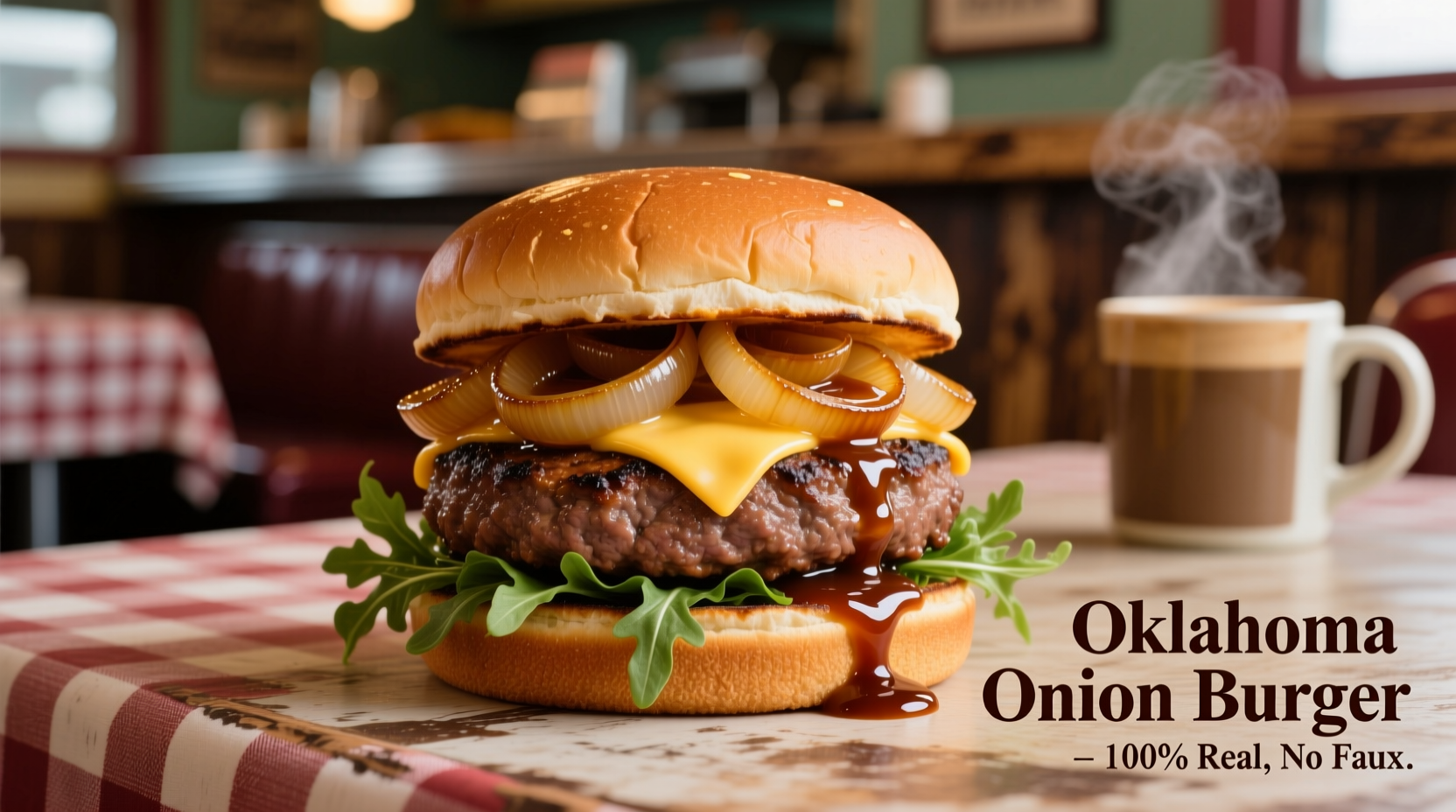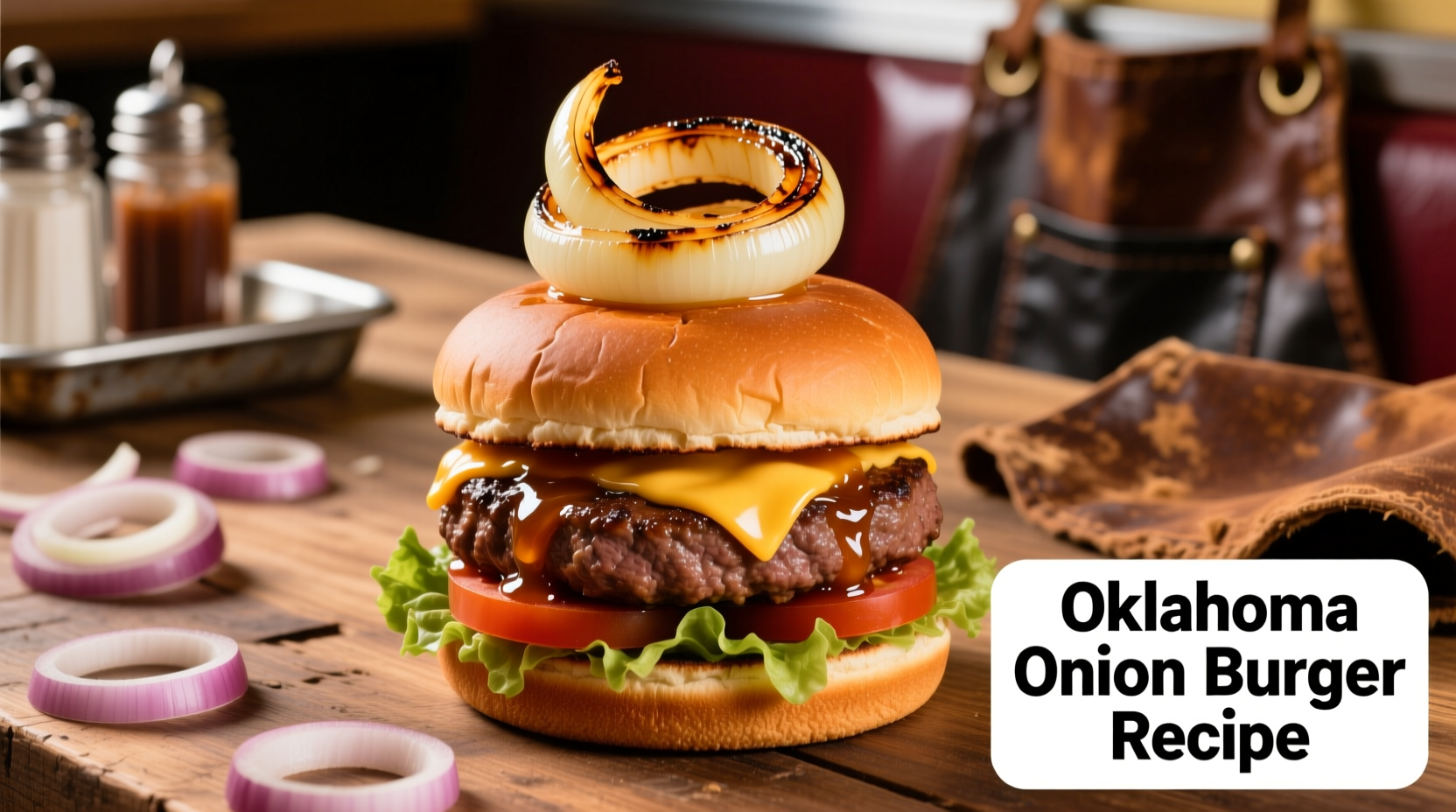The authentic Oklahoma onion burger features a thin, smashed patty with an extraordinary 1:1 meat-to-onion ratio, originating in Depression-era Tulsa as an economical way to stretch precious ground beef. This regional specialty uses yellow onions cooked directly into the patty until caramelized, creating a distinctive sweet-savory flavor profile that defines Oklahoma's culinary heritage.
Nothing captures Oklahoma's culinary spirit quite like the humble onion burger. This isn't just another burger with onions on top—it's a carefully balanced regional specialty where onions aren't a topping but an essential ingredient cooked directly into the patty. Developed during the Great Depression when ground beef was expensive, Oklahoma cooks discovered that smashing thin patties with generous amounts of onions made the meat go further while creating an unexpectedly delicious flavor combination.
Why Oklahoma Onion Burgers Stand Apart
While many regions claim burger variations, Oklahoma's version has distinct characteristics that set it apart. The magic happens when thinly sliced yellow onions hit the hot griddle alongside the meat, releasing sugars that caramelize and fuse with the beef. This creates a crispy-edged patty with sweet onion notes throughout—not just on top. The traditional 1:1 meat-to-onion ratio by volume might seem excessive at first glance, but it's precisely what creates the authentic flavor profile that has made these burgers a staple across Oklahoma diners for nearly a century.
| Burger Style | Meat-to-Onion Ratio | Cooking Method | Regional Origin |
|---|---|---|---|
| Oklahoma Style | 1:1 (by volume) | Smashed thin on griddle | Tulsa, OK (1920s) |
| Chicago Style | 4:1 (by volume) | Grilled medium-rare | Chicago, IL |
| California Style | 3:1 (by volume) | Grilled with toppings | West Coast, USA |
The Evolution of a Regional Classic
Oklahoma onion burgers emerged during the 1920s oil boom when Tulsa was experiencing rapid growth. According to the Oklahoma Historical Society, the first documented onion burgers appeared at small diners catering to oil field workers who needed filling, affordable meals. The technique of smashing onions directly into thin patties served two purposes: it extended the expensive ground beef and created a distinctive flavor that quickly became popular.
By the 1930s, the Oklahoma onion burger had become so widespread that it influenced the national fast-food landscape. White Castle, which opened its first location outside Kansas in Tulsa in 1936, adopted elements of the Oklahoma style, though with less onion. The Oklahoma version remained distinct with its higher onion content and specific cooking technique.

Perfecting Your Oklahoma Onion Burger Recipe
Creating an authentic Oklahoma onion burger requires attention to specific details that differentiate it from ordinary burgers. The cooking technique is as important as the ingredients themselves.
Essential Ingredients
- 1 pound (450g) ground chuck (80% lean, 20% fat)
- 1 pound (450g) yellow onions, thinly sliced
- 4 hamburger buns (preferably potato buns)
- Salt and freshly ground black pepper
- Optional: mustard, pickles, or cheese
Step-by-Step Cooking Process
- Prepare onions: Slice onions paper-thin (about 1/16 inch) using a mandoline for consistency
- Form patties: Divide meat into 4 equal portions without compacting—loose balls work best
- Heat griddle: Preheat to 375°F (190°C)—critical for proper caramelization
- Smash technique: Place meat ball on griddle, immediately cover with flattened onions, and smash thin with a spatula
- Cooking time: 3-4 minutes per side until deeply caramelized and crispy edges form
- Rest and serve: Let rest 1 minute before placing on toasted buns
Avoiding Common Mistakes
Many home cooks miss the mark with Oklahoma onion burgers by making these critical errors:
- Using the wrong onion variety: Yellow onions provide the perfect balance of sweetness and pungency. Red or white onions won't caramelize properly.
- Insufficient onion quantity: Authentic Oklahoma style requires equal volume of onions to meat—not just a few slices on top.
- Over-handling the meat: Form loose balls rather than tightly packed patties for optimal texture.
- Incorrect temperature: Too hot and onions burn; too cool and they won't caramelize properly with the meat.
Regional Authenticity Guidelines
What makes a burger truly an "Oklahoma onion burger" rather than just a burger with onions? According to the Oklahoma Department of Tourism's culinary documentation, three elements define authenticity:
- The onions must be cooked directly with the patty, not added after cooking
- The meat-to-onion ratio must approach 1:1 by volume
- The patty must be smashed thin (1/4 inch or less) during cooking
These parameters distinguish Oklahoma's specialty from similar regional variations. In neighboring states like Texas or Kansas, onion burgers typically use less onion and thicker patties. The Oklahoma version's distinctive sweet-savory flavor comes from the precise balance of these elements.
Serving Traditions
In Oklahoma diners, these burgers are traditionally served "plain" with just mustard and pickles, allowing the onion-beef fusion to shine. The classic presentation includes:
- On a soft potato bun, lightly toasted
- With yellow mustard (never ketchup in authentic establishments)
- Accompanied by dill pickles
- Served with a side of crispy onion bits that cooked off the patty
While cheese variations exist (particularly cheddar), purists argue that adding cheese distracts from the essential onion-beef harmony that defines this regional specialty.
Frequently Asked Questions
What makes an Oklahoma onion burger different from regular burgers?
Oklahoma onion burgers feature a 1:1 meat-to-onion ratio by volume with onions cooked directly into the patty, not added as a topping. The patties are smashed thin (about 1/4 inch) on the griddle, allowing the onions to caramelize with the meat, creating a distinctive sweet-savory flavor profile that defines this regional specialty.
Can I use other onion varieties for authentic Oklahoma onion burgers?
Yellow onions are essential for authentic Oklahoma onion burgers. Their sugar content and flavor profile create the proper caramelization when cooked with the meat. Red onions are too sweet and lack the necessary pungency, while white onions are too sharp and don't caramelize correctly. The Oklahoma Historical Society's culinary archives confirm yellow onions have been used since the dish's Depression-era origins.
Why are Oklahoma onion burgers cooked so thin?
The thin patty (about 1/4 inch) maximizes surface area for proper caramelization of both meat and onions. During the Great Depression, this technique helped stretch limited ground beef supplies while creating more flavorful patties. The high heat on a flat griddle creates crispy edges while allowing the onions to fully integrate with the meat, producing the distinctive texture and flavor that defines Oklahoma's regional specialty.
What's the ideal meat fat content for Oklahoma onion burgers?
80% lean, 20% fat ground chuck is ideal for Oklahoma onion burgers. This fat content provides enough moisture to prevent drying during the high-heat cooking process while allowing proper caramelization. Leaner blends won't develop the characteristic crispy edges, while higher fat content can make the burger greasy. The Oklahoma Department of Agriculture's culinary guidelines recommend this ratio for optimal texture and flavor in traditional preparation.











 浙公网安备
33010002000092号
浙公网安备
33010002000092号 浙B2-20120091-4
浙B2-20120091-4